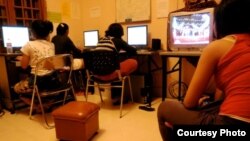Using comic journalism to tell non-fiction stories is not common in the mainstream media. But the hand-crafted and thought-provoking images of Anne Elizabeth Moore have earned a place next to more traditional forms of media.
Moore is an American multi-award-winning artist, writer, journalist and cultural critic. In her recent book, “Threadbare: Clothes, Sex, and Trafficking”, Moore uses vivid comics to allow her readers to witness the complex interconnection of the global apparel trade and women in poverty.
“I want to make it clear that this is a way of using comics that we don’t consider common […] we can tell not just non-fiction stories in comic form, but also actual reporting,” she said.
The book was originally built from a monthly comic journalism series from the Ladydrawers, a group of artists and writers who produce and collect comics and texts about economics, race, sexuality, gender and culture.
Structured in four chapters, the book investigates the machinations of the apparel trade in the U.S., and draws comparisons with Europe’s role in the garment industry and that of the United States.
The book further discusses sex work and the trafficking of women, as well as the work of anti-trafficking organizations in Cambodia.
It was an ambitious project for Moore because of the challenges of combining comic art with reporting.
“I didn’t know that it would unravel completely. I didn’t know that I wanted to do a project about the full supply chain of the garment industry or human trafficking,” she said.
But the book ended up being an “investigative report,” relying on both research, travel, and extensive interviews, she said.
One chapter of the book relies on Moore’s extensive field research in Cambodia since 2014.
She visited numerous anti-trafficking organizations as well as garment factories in Phnom Penh.
From her visits, she became familiar with the NGOs’ work and with factory work.
“What I witnessed in the anti-trafficking NGO was not shocking: totally normal Cambodian women in a large room, sewing apparel. But it wasn’t social services, either. It was a small-scale garment factory,” Moore wrote in an email.
Women account for more than 80 percent of the 600,000 garment workers in Cambodia. In many developing countries, women have been the main driving force for the multi-million-dollar garment industry, providing cheap labor for major international brands.
Among anti-trafficking NGOs, some see garment work as a short-term solution to getting women out of sex work, which creates an economic incentive for women to get a job in the factories, said Moore.
That has to change, she added. Anti-trafficking organizations “should sit down and listen to what their clients need, to offer themselves as resources to try to figure out how to allow women to regain their financial, emotional, and family independence.”









